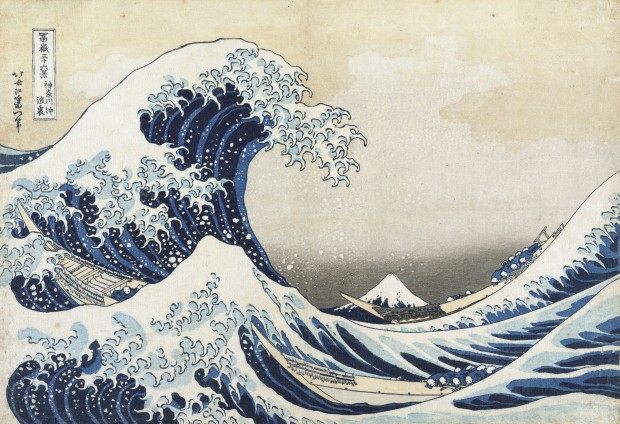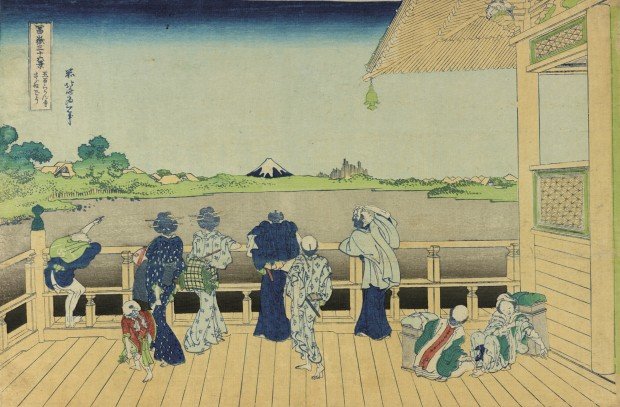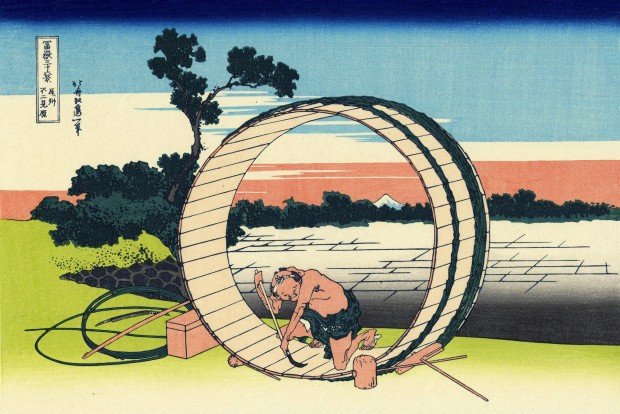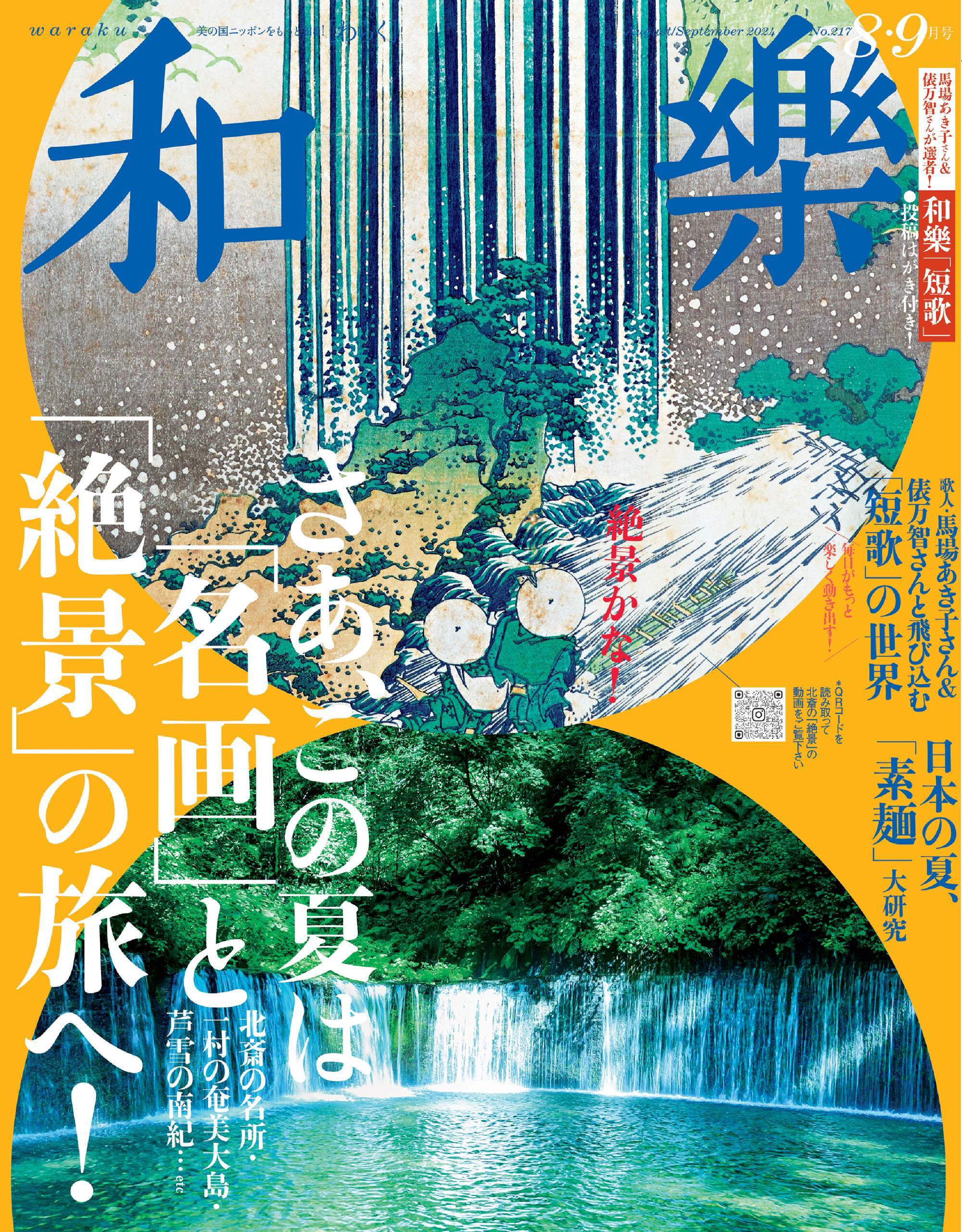The novel and bold compositions of Hokusai
In the world of art history, paintings belonged to the upper echelons of society until relatively recently. In regards to high art, there were many conventional rules and traditions. On the other hand though, when it came to the commoner art of ukiyo-e prints, there were very few restrictions. Ukiyo-e artists quickly achieved many developments while repeatedly drawing subjects and themes that would appease the general public. Within the realm of woodblock prints, artists could freely choose how to portray, compose, and color their work. Displaying their creativity and original styles were great ukiyo-e masters such as Utamaro, Hokusai, Hiroshige, and Kuniyoshi.
This time, let’s take a look at some impressive technical feats by the great 葛飾北斎 (Katsushika Hokusai, 1760-1849). In particular, let’s explore his novel and bold use of perspective. Though not quite at Pablo Picasso’s level, Hokusai did combine several viewpoints into one drawing, resulting in curious and dynamic scenes. The difference? While Cubist artwork aimed to represent subjects in greater context by reassembling multiple, abstracted viewpoints of an objects, Hokusai arranged various points of views into one scene to create a fuller, more dynamic presentation than what a mere photographic copy could offer.
Can you see it too?
For example, in these two prints we find a combination of viewpoints woven into one scene.
 Katsushika Hokusai, “Great Wave off Kanagawa,” 1831, oban-size polychrome woodblock print. Image: Heritage (PPS)
Katsushika Hokusai, “Great Wave off Kanagawa,” 1831, oban-size polychrome woodblock print. Image: Heritage (PPS)
In Hokusai’s 「神奈川沖浪裏」 (“Great Wave off of Kanagawa”), we appear to be viewing the tossing waves and boatmen in the foreground from above, however, Mount Fuji in the back is presented as if looked at head on.
 Katsushika Hokusai, “Sazai Hall – 500 Rakan Temple,” 1831, horizontal oban-sized polychrome woodblock print, Ota Memorial Museum.
Katsushika Hokusai, “Sazai Hall – 500 Rakan Temple,” 1831, horizontal oban-sized polychrome woodblock print, Ota Memorial Museum.
Similarly, in this print titled 「五百らかん寺さざゐどう」 (“Sazai Hall – 500 Rakan Temple”) also in the Thirty-six Views of Mount Fuji series, we again see two viewpoints in one print. The figures of sightseers on the balcony are drawn from a vantage point higher than them, but the landscape spread out before us is not viewed from above, but rather at the same level.
Deconstructing Hokusai’s compositions
 Katsushika Hokusai, 「富嶽三十六景 尾州不二見原」 (“Fujimigahara in Owari Province” from the Thirty-six Views of Mount Fuji series), oban-size polychrome woodblock print, 1830 – 1832, 25.8 × 37.3 cm. Photo: Heritage
Katsushika Hokusai, 「富嶽三十六景 尾州不二見原」 (“Fujimigahara in Owari Province” from the Thirty-six Views of Mount Fuji series), oban-size polychrome woodblock print, 1830 – 1832, 25.8 × 37.3 cm. Photo: Heritage
In this single print depicting the sights from Fujimigahara in Owari Province, 富士山 (Fuji-san, Mount Fuji) is drawn as a small white figure off in the distance. Hokusai used foreshortening with the rice fields between the foreground and the mountain in the background. Though it is not the case, it seems like the narrowly-drawn wooded path bordering the fields leads directly up to Mount Fuji!
Another interesting point lies in how the barrel appears to be lying on the ground at an angle facing the left hand side. In that case, we expect the figure of the cooper working inside to also be positioned at a left-facing angle, yet, the cooper’s figure is angled to the right. As a result, it is unclear from where one is viewing this scene. Meanwhile, the barrel’s opening serves as a frame for the subject of the print, Mount Fuji. Despite its location in the distance, the sacred mountain has presence. How so? Let’s find out! From now we take a look at several of Hokusai’s compositional techniques that make this print stand out.
What to look for in this print!
Though small, the white peak captures our attention and makes Mount Fuji a focal point
The distant Mount Fuji is drawn very small, so Hokusai employed a white color to give the mountain presence. The white color does not carry any special meaning, but rather, Hokusai had the idea to use a bright color in order to make the peak stand out.
Is this a frame for Mount Fuji!?
The giant barrel forms a circular frame around Mount Fuji and draws attention to its triangular shape sitting near the center, peeking above the trees. Despite being far off, Mount Fuji jumps into our field of view thanks to this framing technique. Those who first notice the barrel-maker will inevitably have their eyes guided to Mount Fuji too, as they share the same space.
Repeated rings widen the foreground
Next to the barrel under construction lies some casually coiled binding used to hold the barrel together. A rhythmical feeling is created from the many layers of loops combined with the circular shape of the barrel. The addition of the binding coils additionally adds depth to the foreground and opens up the horizontal plane.
From his use of cropping and color techniques to add emphasis to his collage of various viewpoints and use of perspective drawing, Hokusai was unparalleled in his impressive construction of a scene.
Translated and adapted by Jennifer Myers.












